Customer reviews run the gamut from sharing effusive praise and enthusiastic recommendations, to detailing minor complaints and mishaps, to raging about genuine failures. But rest assured, every person who leaves a review is checking back to see if they get a response, and knowing how to respond to a negative review is a skill worth honing.
When your business responds to reviews, it’s important to get the message and the tone right. Ninety-one percent of 18 to 34-year-olds trust reviews as much as personal recommendations, and almost 50% of local consumers feel the same — that’s how much weight reviews carry. The right response can help dissatisfied customers come away feeling heard and confident in a solution, and it can help satisfied customers stay loyal to your business. And don’t forget: the right response can also inspire potential customers to give your business a try.
In that spirit, we will discuss why review responses matter so much. We also cover a list of common mistakes businesses make when replying to reviews and what to do instead — including how to respond to a negative review — so you can have more productive interactions.
Why you should respond to customer reviews
Online reviews on Google, Facebook, Yelp, and industry-specific sites like Zillow or Healthgrades give customers an opportunity to share the real-life experiences they had with your business — which helps potential customers searching for a local business in your category know whether to choose you.
Reviews are important enough on their own. But when you reply to reviews, you have an opportunity to affect the impressions of both past and future customers and help shape your brand’s present image. For example, by simply knowing how to respond to a bad review, you can transform that reviewer’s perception of your brand. Or, by acknowledging and celebrating positive comments, you can secure a customer’s loyalty and turn them into a customer for life.
Effective engagement with reviews — no matter the sentiment — builds credibility with your audience because it shows them you’re paying attention, listening to, and taking seriously what they have to say.
But we recognize that responses can also be tricky and sometimes it’s easy to mess them up, which is what we’ll focus on next.
10 common review response mistakes and how to avoid them
Now that you know why replying to reviews is essential, let’s take a look at some common mistakes when responding and what to do instead. You’ll learn how to respond to a negative review and other review scenarios more effectively.
1. Ignoring negative reviews
Sometimes businesses don’t reply to negative reviews because they don’t want to draw attention to them. It can be tempting to just focus on the positive reviews where customers are thanking your business, praising your offerings, or just generally being positive. Who wouldn’t want that? We all love to be praised and feel appreciated.
But this strategy can have the opposite effect of what’s intended: it can make the negative reviews stand out even more since they’re the only ones without responses. This can make your business seem like it only cares about the happy customers, and that any complaints or concerns don’t really matter.
What to do instead:
Make it a priority to monitor for and respond to negative reviews. Prospective customers need to see that when something didn’t go well with another customer, your business was proactive in addressing the problem and willing to make it right.
This review doesn’t have a response from the business owner or manager. Anyone reading the review may assume the issue hasn’t been fixed in the last four months:
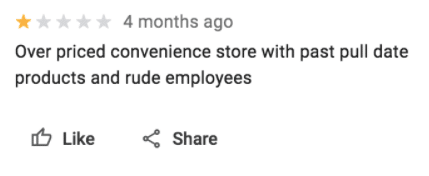
One way to respond to negative review — at the time it’s posted — could be:
“I sincerely apologize for your negative experience. I plan to review inventory and customer service practices with my team to ensure this doesn’t happen again.”
2. Using your response as a chance to boast or advertise
Review responses are supposed to show that you value your customers’ honest feedback and want to understand more about their needs and preferences.
However, if you’re using review replies as a billboard for promoting your latest offer or a place to expound about your company’s mission or values, you’ll risk coming across as insincere. Customers prefer to engage with businesses that aren’t putting themselves first or only seem like they’re in it for the profit.
What to do instead:
Rather than jumping to promote your brand or quote your mission statement, analyze the specifics of the complaint or feedback and either identify a solution or show appreciation for what was positively expressed — and then leave it at that.
While this review response does the right thing by suggesting an offline discussion, the business takes it too far by pushing its ethos:
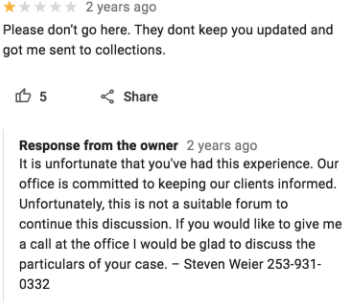
One way to respond instead could be:
“I’m sorry you had this experience. Please call me at [phone number] so I can hear the details of your situation and provide further assistance.”
3. Arguing with the customer over the details
This one can be difficult not to do, especially when a review seems confusing or totally off base. When customers complain, they’re not always going to get the details exactly right, and it can make the problem seem worse than it is. But it doesn’t mean they don’t have a legitimate complaint — and your response is not the place to argue over the specifics of their experience.
Remember, everyone can see your review response — not just the review author. And how you come across can impact the way potential customers think about you. Do you seem petty and aggressive, or grounded and neutral? Ultimately, how you respond to a bad review isn’t about winning an argument but finding suitable solutions that encourage detractors to give your business a second chance.
What to do instead:
First and foremost, remain solution-oriented — i.e., pinpoint the exact problem and how it can be fixed. If you need to ask the customer for additional details to fully understand the issue, then offer to take the conversation offline. You can provide contact info in your review reply and ask them to get in touch with you to explain further.
Here, the restaurant tried to rectify the mistake at the time by bringing another bowl of soup, but the customer was still annoyed. Using the review response to argue about the original attempt to make it right won’t help:

One way to respond could simply be:
“We sincerely apologize for the soup mix-up. We’d love the chance to serve you again and give you a much better experience.”
4. Replying late
Better late than never is true in the world of review responses. That’s because it’s so easy for businesses to get busy and for staff to get overwhelmed. Before you know it, review management falls through the cracks and suddenly you’re catching up on old reviews. But if you’re consistently weeks or even months behind in replying to customer reviews, it can give the impression that you can’t be bothered.
And here’s the thing: You may think customers won’t notice when you reply to their reviews. But Google sends customers an email notification alerting them to a new business reply, so there’s no getting around the date that appears. Bottom line: review response times matter — especially when you’re learning how to respond to negative reviews with greater success.
What to do instead:
If you’re just now starting a review response campaign, don’t panic. You can start by being selective about which older reviews you reply to, such as choosing ones that are more detailed or mention specific issues which your business later fixed. You can say that although it’s been a while since the review was written, you still care about the customer’s feedback. Also note any changes you’ve made in your business and encourage the customer to revisit your business.
Then, going forward, prioritize customer reviews and respond to all of them as quickly as possible. And don’t underestimate the value of a good review management platform. It’s a great way to automate your review processes and customize review notifications so you can stay on top of it while saving precious time.
Even though this hair salon review is two years old, the business manager or owner could still follow up with an apology and a solution to encourage the dissatisfied customer to give them another chance. A late reply is better than ignoring the review:

One way to respond to the negative review could be:
“I’m sorry you had a bad experience with your blowout and that we’re just now reading this. We’re making sure our entire team is up-to-date on training and techniques to avoid problems like this. If you’re interested in trying us again, please accept a 15% discount on your next haircut. You can call me directly at [phone number] and I’ll make sure the front desk applies the discount when you book.”
5. Not engaging with the actual problem
When there are a lot of reviews to reply to, it’s easy to miss key details. In a sincere attempt to keep up with review responses, thoroughness can fall by the wayside.
But customers can sniff out a vague or canned response right away. “If there’s anything we can do to help, let us know” doesn’t add any real value.
What to do instead:
Take the time to read each review carefully to pick up on all the details before responding. Always address the customer’s specific problem(s) and engage with any suggestions they may make. Being able to truly hone in on what’s being said can make a real difference with your current and future customers.
In this review, the salon owner’s response to the bad review doesn’t actually engage with the problem: the client was in pain during treatment and received subpar service. Sure, the client might have been late, but the owner doesn’t address the real issues in the review:
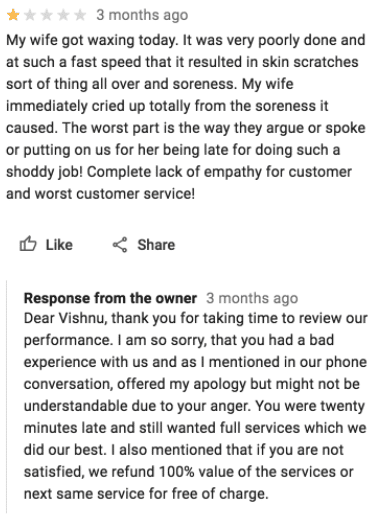
One way to respond could be:
“Thank you for taking the time to leave a review. I’m so sorry your wife had a painful experience and received poor treatment by our staff. Please accept a full refund or your wife can book the same service again free of charge. You can call me directly at [phone number] to let me know what you prefer.”
6. Only caring about serious complaints
Don’t get us wrong: as we’ve already discussed, replying to complaints and negative feedback should be a top priority for your business. But you can go too far in that direction by only addressing the most urgent scenarios and not engaging with the neutral and positive reviews too.
There’s a good reason to respond to a negative review that outlines a major problem, and to do it ASAP, but not at the expense of every other review. Each review response provides an invaluable opportunity to strengthen customer relationships — making the customer feel like a valued part of your business and that their opinions matter.
What to do instead:
Reply promptly to all types of reviews to assure customers that you value any and all feedback — not just the disasters or unusual situations — and that you welcome their suggestions.
This positive review is a great moment for the business to strengthen their relationship with the happy customer:

One way to respond could be:
“Thank you for taking the time to leave this review! We love that you love our organic produce and bakery, and that our delivery service is meeting your needs. Let us know if you have any suggestions for what else we can offer to best serve our customers.”
7. Leaving the customer without a solution
Reviewers need a clear idea of what the next steps are when they’ve shared a negative experience. Though finding the right solution sometimes means taking the conversation offline, you never want to just leave the customer hanging. A key part of learning how to respond to a negative review appropriately is to focus on the solution itself.
Also, once your business leaves a response, customers can’t reply again. So if there’s no obvious solution or next steps offered on the first go-round, they’ll have a hard time knowing if their problem will actually be fixed. The result? An already-angry customer gets angrier.
What to do instead:
Always propose a solution or two that you or the customer can put into action right away. And if you need more information before you can do that, make it super easy for the customer to get in touch with you — whether by phone, email, or a physical address. Being straightforward about solutions makes it more likely the customer will forgive the mistake and come back.
Here’s how an HVAC business offered a solution to a delay in communication that affected a customer:
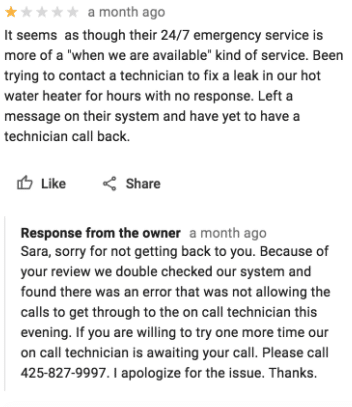
One way to respond could be:
Wait a minute. This is already a great response and a reasonable solution the customer can put into action right away. Clearly this business has figured out how to respond to a bad review. No need to improve on it.
8. Making it generic
Generic-ness deserves its own item here. And that’s because customers are individuals. They have their own worries, preferences, and needs. When communicating with a business, they want to be seen and understood, and don’t want to feel like they’re talking to a robot.
If you say the same thing in every review response, it looks like your business deals with customers by rote and doesn’t do anything to tailor experiences or interactions. Even though some reviews may be near identical themselves, it’s still important to personalize each response as much as you can.
What to do instead:
Even if you’re acknowledging positive feedback, try to write original responses. Simple touches like using the reviewer’s name and including the exact product or service they mentioned ensures your responses are authentic and unique to the individual.
Here’s a short response to some positive feedback that could go even further:
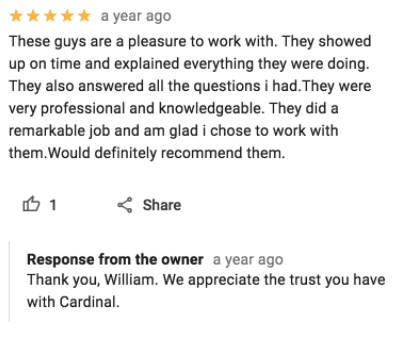
Another way to respond could be:
“Thank you, [customer name]. We’re glad that our team was on time and acted in a professional manner. This is what we like to hear. We appreciate any recommendations and look forward to serving you again.”
9. Thinking that a “thank you” is enough
Review overwhelm can make it tempting to say a quick thanks in response to a positive review — and then move on to the next. But as we’ve been discussing, if you’re not fully engaging with the sentiment and content of each review, you’re losing an opportunity to authentically connect with your customer.
“Thank you” is nice. “Thank you” is appreciated. “Thank you for your feedback” is a good way to start a response to a negative review and can take some of the edge out of an unhappy customer. But it shouldn’t stop there.
What to do instead:
If you want to wow your customer in a review response and increase your chances of turning them into customers for life, don’t hold back. In addition to expressing genuine gratitude, aim for clever, funny, warm, delighted, humble — whatever closely reflects the voice of your brand or business and appropriately matches the sentiment of the review.
Here’s a simple review that nevertheless deserves a personalized response:

One way to respond could be:
“Thank you for your review, from our family to yours. We’re happy to give customers like you a great dining experience without breaking the bank. Hope to see you again soon.”
10. Being defensive in your response to a negative review
This one goes hand-in-hand with not arguing over the details. It’s really hard not to take a negative review personally. When someone is criticizing your business — fairly or unfairly — it feels natural to want to defend yourself.
But online reviews are not a court of law where defending yourself is imperative to prevent or correct a wrong. As a business owner, your job is to maintain a cool head. Taking the bait and getting defensive will only aggravate the customer and put you farther away from a solution that works for both of you.
What to do instead:
Try to understand the situation from the customer’s perspective. Were they ticked off by slow service? Were they disappointed that a specialty item on the menu sold out? Was it their second appointment and they were expecting more? Putting yourself in the customer’s shoes gets you into an empathetic mindset — which is what you need to truly make it right with the customer.
Although this response tries to find out more about the issue, it comes off as slightly defensive, as if the owner is questioning the customer’s experience:

One way to respond instead could be:
“I’m sorry we disappointed you. It sounds like you prefer your cold brew extra strong, and we didn’t deliver. We’re happy to adjust orders to suit our customers’ taste, and would like the chance to do that for you on your next visit.”
Final thoughts
Making these mistakes when replying to reviews is common. But once you know how to think about reviews, how to respond to a bad review — and all reviews for that matter — gets easier. You’ll find an approach that encourages both fans and detractors to continue doing business with you.
The key is to treat reviews individually and reply promptly and authentically. Approach customer feedback with an open mind and lean into both positive and negative comments. That way you’ll be able to be more empathetic and provide better solutions when issues arise.
Want to make sure you never miss another customer review again? Enjoy a free 14-day trial of GatherUp and see how easy it is to monitor for, request, gather, and quickly respond to reviews.
